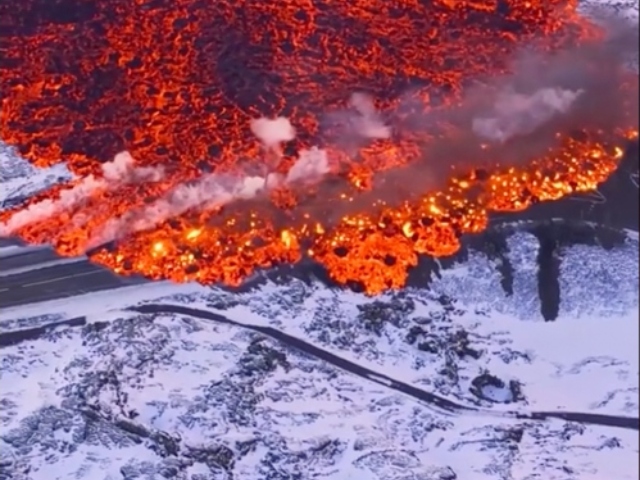
-
Fire And Ice In Iceland As Another Lava Fissure Opens Up, Leaving Residents In The Cold [Videos]
12 Feb 2024 by Tayla in Disaster, Environment, Lifestyle, Natural Disasters, Nature, Video, Weather, World
[imagesource:tiktok]
The hot magma underneath Iceland is rising ever faster.
A state of emergency has been called, with more than 20,000 people reportedly having their hot water supply disrupted after more lava burst key water pipes in Iceland.
This marks the third volcanic eruption to hit the Reykjanes peninsula since September.
Iceland has more than 100 volcanoes and more than 30 are currently active, but pinpointing exactly where an eruption will happen is the ultimate challenge. That’s because the volcanoes aren’t cone-shaped like Italy’s Mount Etna, for example, where the lava comes out at more or less the same place. The magma in the Reykjanes Peninsula is mostly held loosely under a larger area that erupts through cracks, or fissures, that can be kilometres long.
The Icelandic authorities have been furiously building large barriers around the town and power stations, which are good at holding lava back, but if a fissure opens up inside the barriers – as was the case in Grindavik in January when some houses were destroyed – not much can be done.
Dramatic aerial footage of the recent eruption shows the lava spreading over the snowy landscape, showcasing the epic war between fire and ice:
@impressiveiceland #Repost @jvn.photo —— Here we go again! The sixth eruption on Reykjanes Peninsula in Iceland kicked off this morning. I recorded this clip this morning as lava very quickly begun taking over the snow-covered landscape. Fortunately, it erupted in the same location as the December eruption, which means it is far away from Grindavík. Some damages have already occurred, with two roads and a hot water pipe being the most significant ones. I went on-site and documented a lot of the developments for several foreign media stations. I am absolutely mind-blown at what I witnessed there. #iceland 📷 This was captured using the DJI Mavic 3 Pro using the telephoto lens. The fast flowing lava is so incredibly hot, it actually damaged the wide-angle camera on my drone. • • #iceland #icelandrip #icelandroadtrip #visiticeland #exploreiceland #icelandtravel #icelandscape #guidetoiceland #icelandnature #icelandadventure #discovericeland #wheniniceland #inspiredbyiceland #icelandic #icelandicnature #discoverearth #beautifuldestinations ♬ original sound – Impressive Iceland @climeradar This aerial footage is wild 😶 #grindavik #reykjanes #peninsula #reykjanespeninsula #lava #flow #magma #volcano #erupt #eruption #volcanoeruption #water #waterpipe #road #aerial #drone #crazy #wild #scary #evacuate #evacuation #fyp #weather #nature #clime #climeapp ♬ оригинальный звук – Clime The BBC notes that Iceland could be entering a new volcanic era and that a long period of eruptions will have major consequences for the region:
“This is the most densely populated part of Iceland – so 70% of the population lives within 40km or so,” explains Dr Evgenia Ilyinskaya, a volcanologist from the University of Leeds.
“And all of the key infrastructure is there – so the main international airport, big geothermal power plants, and a lot of tourist infrastructure too, which is a big part of Iceland’s economy.”
The recent bout of lava not only engulfed a pipeline, cutting some communities off from heat and hot water, but also forced one of the country’s biggest tourist attractions to close. Visitors from all over the world come to the Blue Lagoon to experience the country’s geothermal spa culture, but now that’s been put to a stop:
Iceland is positioned above a geological hotspot, where plumes of hot material deep within the Earth rise towards the surface. The country also sits on the boundary between the Eurasian and North American tectonic plates, which are very slowly pulling apart from each other, creating a space for hot molten rock – or magma – to flow up.
Dr Ilyinskaya says that now that the eruptions are repeating themselves, scientists have a much better idea of what is happening:
“So they’ve been tracking how the ground is inflating as magma is coming out from deep below. And now they actually can tell with a lot more certainty than was possible when to expect the magma to start breaking through the ground.”
Scientists are looking at a number of different volcanic systems that sit across the peninsula.
“In the last cycle, the first eruptions started in the systems to the east and migrated to the west, with a few fits and starts here and there,” explains Dr Dave McGarvie from Lancaster University.
McGarvie added that scientists are questioning if the inactivity is a temporary lull or the end of the phase of activity; “we’re into unknown territory at that point,” he concluded.
Although scientists are learning more with every eruption, there’s still a great deal of uncertainty for Iceland as a new volcanic era begins.
[source:bbc]
Latest News
-
Game, Seth, Match – Goodbye 2024
Hey Guys - thought I’d just give a quick reach-around and say a big thank you to our rea...
-
Breakfast Of Champions: Hollywoodbets Kenilworth Racecourse Breakfast Gallops Is Back!
[imagesource:CapeRacing] For a unique breakfast experience combining the thrill of hors...
-
Need NYE Plans? Cafe Caprice’s Night Of Enchantment Masquerade Party Could Do The Trick
[imagesource:howler] If you're still stumped about what to do to ring in the new year -...
-
Buckingham Palace Steps In After Staff Christmas Party Spirals Out Of Control
[imagesource:maxandeli/facebook] It's not just in corporate that staff parties get a li...
-
Designer Babies Are Running Into Trouble As Teens, Grappling With Being ‘Experiments’
[imagesource:here] Imagine being born with the weight of your parents’ version of per...
-






























